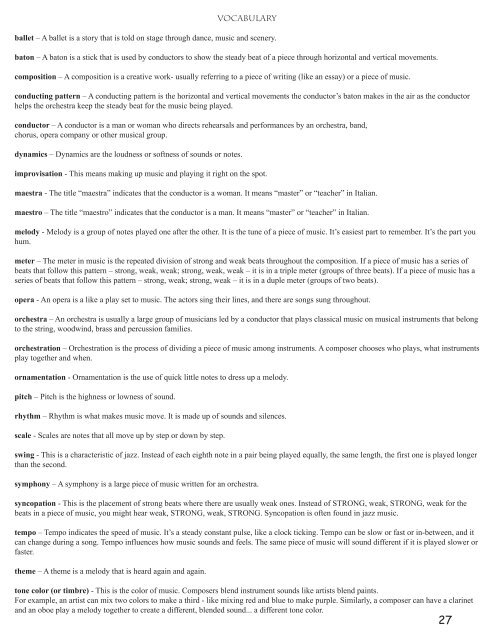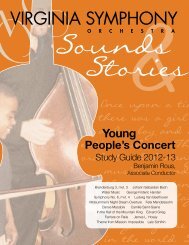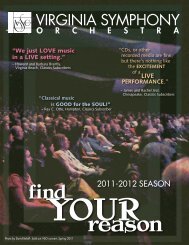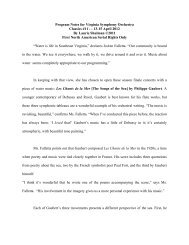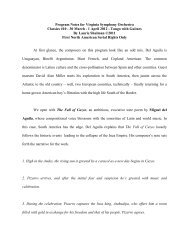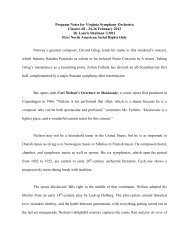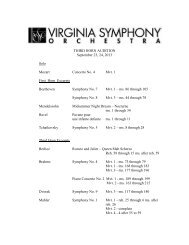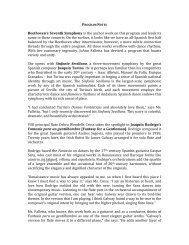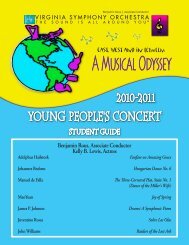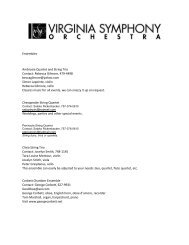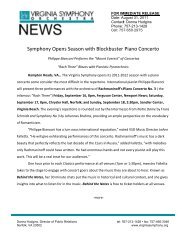outhful Young People's Concert - Virginia Symphony Orchestra
outhful Young People's Concert - Virginia Symphony Orchestra
outhful Young People's Concert - Virginia Symphony Orchestra
Create successful ePaper yourself
Turn your PDF publications into a flip-book with our unique Google optimized e-Paper software.
Vocabulary<br />
ballet – A ballet is a story that is told on stage through dance, music and scenery.<br />
baton – A baton is a stick that is used by conductors to show the steady beat of a piece through horizontal and vertical movements.<br />
composition – A composition is a creative work- usually referring to a piece of writing (like an essay) or a piece of music.<br />
conducting pattern – A conducting pattern is the horizontal and vertical movements the conductor’s baton makes in the air as the conductor<br />
helps the orchestra keep the steady beat for the music being played.<br />
conductor – A conductor is a man or woman who directs rehearsals and performances by an orchestra, band,<br />
chorus, opera company or other musical group.<br />
dynamics – Dynamics are the loudness or softness of sounds or notes.<br />
improvisation - This means making up music and playing it right on the spot.<br />
maestra - The title “maestra” indicates that the conductor is a woman. It means “master” or “teacher” in Italian.<br />
maestro – The title “maestro” indicates that the conductor is a man. It means “master” or “teacher” in Italian.<br />
melody - Melody is a group of notes played one after the other. It is the tune of a piece of music. It’s easiest part to remember. It’s the part you<br />
hum.<br />
meter – The meter in music is the repeated division of strong and weak beats throughout the composition. If a piece of music has a series of<br />
beats that follow this pattern – strong, weak, weak; strong, weak, weak – it is in a triple meter (groups of three beats). If a piece of music has a<br />
series of beats that follow this pattern – strong, weak; strong, weak – it is in a duple meter (groups of two beats).<br />
opera - An opera is a like a play set to music. The actors sing their lines, and there are songs sung throughout.<br />
orchestra – An orchestra is usually a large group of musicians led by a conductor that plays classical music on musical instruments that belong<br />
to the string, woodwind, brass and percussion families.<br />
orchestration – <strong>Orchestra</strong>tion is the process of dividing a piece of music among instruments. A composer chooses who plays, what instruments<br />
play together and when.<br />
ornamentation - Ornamentation is the use of quick little notes to dress up a melody.<br />
pitch – Pitch is the highness or lowness of sound.<br />
rhythm – Rhythm is what makes music move. It is made up of sounds and silences.<br />
scale - Scales are notes that all move up by step or down by step.<br />
swing - This is a characteristic of jazz. Instead of each eighth note in a pair being played equally, the same length, the first one is played longer<br />
than the second.<br />
symphony – A symphony is a large piece of music written for an orchestra.<br />
syncopation - This is the placement of strong beats where there are usually weak ones. Instead of STRONG, weak, STRONG, weak for the<br />
beats in a piece of music, you might hear weak, STRONG, weak, STRONG. Syncopation is often found in jazz music.<br />
tempo – Tempo indicates the speed of music. It’s a steady constant pulse, like a clock ticking. Tempo can be slow or fast or in-between, and it<br />
can change during a song. Tempo influences how music sounds and feels. The same piece of music will sound different if it is played slower or<br />
faster.<br />
theme – A theme is a melody that is heard again and again.<br />
tone color (or timbre) - This is the color of music. Composers blend instrument sounds like artists blend paints.<br />
For example, an artist can mix two colors to make a third - like mixing red and blue to make purple. Similarly, a composer can have a clarinet<br />
and an oboe play a melody together to create a different, blended sound... a different tone color.<br />
27


